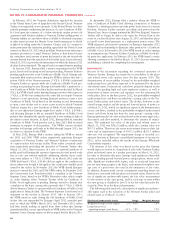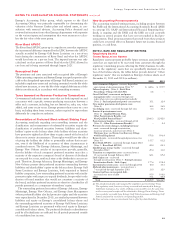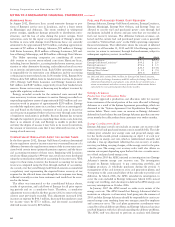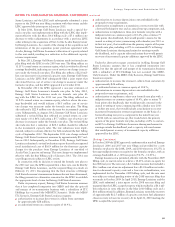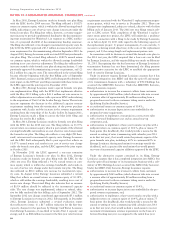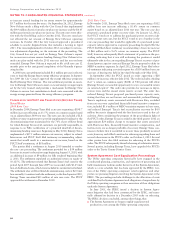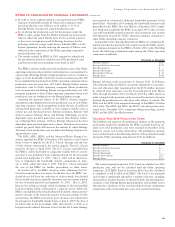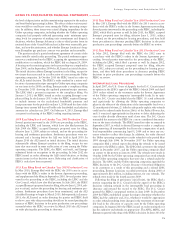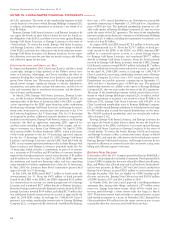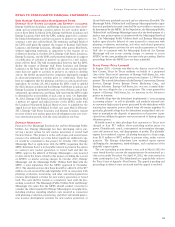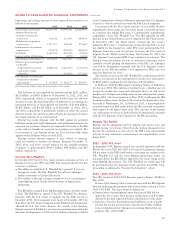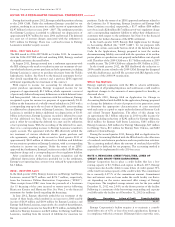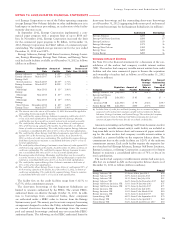Entergy 2012 Annual Report Download - page 71
Download and view the complete annual report
Please find page 71 of the 2012 Entergy annual report below. You can navigate through the pages in the report by either clicking on the pages listed below, or by using the keyword search tool below to find specific information within the annual report.
Entergy Corporation and Subsidiaries 2012
NOTES TO CONSOLIDATED FINANCIAL STATEMENTS continued
n In order to reach rough production cost equalization, the FERC
imposed a bandwidth remedy by which each company’s total
annual production costs will have to be within +/- 11% of
Entergy System average total annual production costs.
n In calculating the production costs for this purpose under the
FERC’s order, output from the Vidalia hydroelectric power plant
will not reflect the actual Vidalia price for the year but is priced
at that year’s average price paid by Entergy Louisiana for the
exchange of electric energy under Service Schedule MSS-3 of the
System Agreement, thereby reducing the amount of Vidalia costs
reflected in the comparison of the Utility operating companies’
total production costs.
n The remedy ordered by FERC in 2005 required no refunds and
became effective based on calendar year 2006 production costs
and the first reallocation payments were made in 2007.
The FERC’s decision reallocates total production costs of the Utility
operating companies whose relative total production costs expressed as
a percentage of Entergy System average production costs are outside an
upper or lower bandwidth. Under the current circumstances, this will
be accomplished by payments from Utility operating companies whose
production costs are more than 11% below Entergy System average
production costs to Utility operating companies whose production
costs are more than the Entergy System average production cost, with
payments going first to those Utility operating companies whose total
production costs are farthest above the Entergy System average.
Assessing the potential effects of the FERC’s decision requires
assumptions regarding the future total production cost of each Utility
operating company, which assumptions include the mix of solid fuel
and gas-fired generation available to each company and the costs of
natural gas and purchased power. Entergy Louisiana, Entergy Gulf
States Louisiana, Entergy Texas, and Entergy Mississippi are more
dependent upon gas-fired generation sources than Entergy Arkan-
sas or Entergy New Orleans. Of these, Entergy Arkansas is the least
dependent upon gas-fired generation sources. Therefore, increases in
natural gas prices likely will increase the amount by which Entergy
Arkansas’s total production costs are below the Entergy System aver-
age production costs.
The LPSC, APSC, MPSC, and the Arkansas Electric Energy Con-
sumers appealed the FERC’s December 2005 decision to the United
States Court of Appeals for the D.C. Circuit. Entergy and the City
of New Orleans intervened in the various appeals. The D.C. Circuit
issued its decision in April 2008. The D.C. Circuit concluded that
the FERC’s orders had failed to adequately explain both its conclu-
sion that it was prohibited from ordering refunds for the 20-month
period from September 13, 2001 - May 2, 2003 and its determina-
tion to implement the bandwidth remedy commencing on Janu-
ary 1, 2006, rather than June 1, 2005. The D.C. Circuit remanded
the case to the FERC for further proceedings on these issues.
In October 2011, the FERC issued an order addressing the D.C.
Circuit remand on these two issues. On the first issue, the FERC con-
cluded that it did have the authority to order refunds, but decided
that it would exercise its equitable discretion and not require refunds
for the 20-month period from September 13, 2001 - May 2, 2003.
Because the ruling on refunds relied on findings in the interruptible
load proceeding, which is discussed in a separate section below, the
FERC concluded that the refund ruling will be held in abeyance pend-
ing the outcome of the rehearing requests in that proceeding. On the
second issue, the FERC reversed its prior decision and ordered that
the prospective bandwidth remedy begin on June 1, 2005 (the date of
its initial order in the proceeding) rather than January 1, 2006, as it
had previously ordered. Pursuant to the October 2011 order, Entergy
was required to calculate the additional bandwidth payments for the
period June - December 2005 utilizing the bandwidth formula tariff
prescribed by the FERC that was filed in a December 2006 compli-
ance filing and accepted by the FERC in an April 2007 order. As is the
case with bandwidth remedy payments, these payments and receipts
will ultimately be paid by Utility operating company customers to
other Utility operating company customers.
In December 2011, Entergy filed with the FERC its compliance fil-
ing that provides the payments and receipts among the Utility operat-
ing companies pursuant to the FERC’s October 2011 order. The filing
shows the following payments/receipts among the Utility operating
companies (in millions):
Payments or (Receipts)
Entergy Arkansas $156
Entergy Gulf States Louisiana $ (75)
Entergy Louisiana $ –
Entergy Mississippi $ (33)
Entergy New Orleans $ (5)
Entergy Texas $ (43)
Entergy Arkansas made its payment in January 2012. In February
2012, Entergy Arkansas filed for an interim adjustment to its produc-
tion cost allocation rider requesting that the $156 million payment
be collected from customers over the 22-month period from March
2012 through December 2013. In March 2012 the APSC issued an
order stating that the payment can be recovered from retail customers
through the production cost allocation rider, subject to refund. The
LPSC and the APSC have requested rehearing of the FERC’s October
2011 order. The APSC, the LPSC, the PUCT, and other parties inter-
vened in the December 2011 compliance filing proceeding, and the
APSC and the LPSC also filed protests.
CALENDAR YEAR 2012 PRODUCTION COSTS
The liabilities and assets for the preliminary estimate of the payments
and receipts required to implement the FERC’s remedy based on cal-
endar year 2012 production costs were recorded in December 2012,
based on certain year-to-date information. The preliminary estimate
was recorded based on the following estimate of the payments/receipts
among the Utility operating companies for 2013 (in millions):
Payments or (Receipts)
Entergy Arkansas $ –
Entergy Gulf States Louisiana $ –
Entergy Louisiana $ –
Entergy Mississippi $ –
Entergy New Orleans $(17)
Entergy Texas $ 17
The actual payments/receipts for 2013, based on calendar year 2012
production costs, will not be calculated until the Utility operating
companies’ 2012 FERC Form 1s have been filed. Once the calculation
is completed, it will be filed at the FERC. The level of any payments
and receipts is significantly affected by a number of factors, including,
among others, weather, the price of alternative fuels, the operating char-
acteristics of the Entergy System generating fleet, and multiple factors
affecting the calculation of the non-fuel related revenue requirement
components of the total production costs, such as plant investment.
69



